Mahurangi Magazine illustrates the dolphin and the dole queue

21st Century Canyoning: In the interests of bringing David Cunliffe’s epic policy-positioning speech to a wider audience, it is republished here, with pictures. For the record, the Mahurangi Magazine believes the canyon that Dr James Martin (pictured) predicts civilisation must squeeze through this century, calls for (a.) non-partisan grand-coalition government, and (b.) David Cunliffe to have a more important role than that of prime minister—say, minister of mobilisation. image University of Manchester
Hon David Cunliffe
Member of Parliament for New Lynn
Labour Party economic development and associate finance spokesman
Clean-tech cluster chairman
Titirangi War Memorial Hall
23 June 2012
Since I became a father, everything I did before seems rather shallow and selfish.
I feel incredibly lucky and grateful that I have the good fortune to live in one of the few remaining places on earth that has a stable democracy, food, education, healthcare and, above all, a healthy environment.
How much longer will this paradise last? I’m not sure. I’m very sad to say there’s a very good chance that by the time my two young sons reach adulthood, the safe and healthy world that we all took for granted will be gone. Finished.
When we look back on it, the worst crisis of the 21st century won’t be the ‘Great Recession’ since the global financial crash of 2008—it will be the ‘Great Compression’ that is coming at us because of energy shocks, climate change, population growth and resource shortage. In a book called The Meaning of the 21st Century1, James Martin likened the first half of the century to a funnel that humankind will have to pass through to reach a more sustainable future, or any future at all.
Sure, we will have to both protect dolphins and shorten dole queues, which is what you will be expecting from the title of this speech. But actually, the nature of this crisis is far deeper and more fundamental than the standard environment-economy trade-off thinking might suppose. The coming crisis threatens more than just marine biodiversity. The species we are trying to save could be our own.
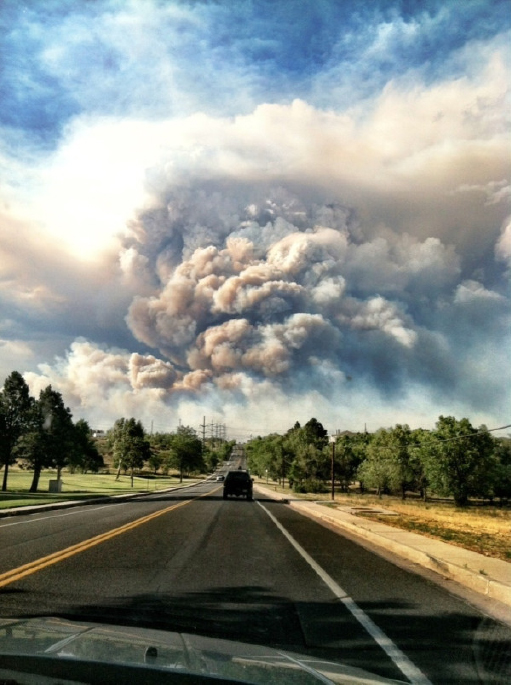
Fuelling the Flames: Fundamental to the predicament facing civilisation whereby humanity and as many other species possible must be funnelled through the fossil-fuel phase-out canyon, is population growth, not least of all in the grossly over-consuming North. More immediately, global warming is pouring fuel on wildfire events such as that raging in Waldo Canyon—aside from the heat wave, Colorado is part of the desert southwest, which is predicted to reach 1930s Dust Bowl conditions in the next several decades, and last winter the snowpack was 2% of normal, and warmer winters have caused mountain pine beetle beetles to thrive, killing 90% of some forests. image via Climate Progress
Outline
In that context today I am going to say three things: First, why these risks are fundamental and in some cases life-threatening. Second, what contribution smart, clean technology and renewable energy could make to addressing the risks and providing a way forward. Third, we should not pretend that just ‘installing solar water heaters’ is going to save the planet on its own.
And fourth, how we can begin to think logically and clearly about making the tough decisions and trade-offs that are ahead of us. One thing is certain—much stronger action will be needed. Much will depend on each and every one of you, as well as on future governments.
Storm clouds looming
Population and consumption
Let me point out a few really sobering facts.
In 1350, at the end of the Great Famine and the Black Death, the world’s population was about 370 million. By 1750, this had almost doubled to 760 million. By 1950, the world had 2.5 billion people and already in my lifetime the world’s population has doubled once more2.
No one, no one, no one believes that the human population on planet Earth can safely hit nine or ten billion without grave consequences. In a sense, there’s no guilty party and no bad guys; just seven billion bewildered humans whose dreams came true: against all odds, we survived and flourished. We reproduced, organised and colonised the entire planet.
Our ancestors bred like rabbits because it was the only way of guaranteeing survival. Also, because there was no old-age pension, large families were the only way of ensuring that there would be sufficient family members to look after the parents when they grew too old to work.

Good Coming from Goodluck: While it is not for the North to tell the South not to breed and consume resources, President Goodluck Jonathan has no qualms in telling his fellow Nigerians they must contemplate a one-child policy similar to that which has averted catastrophe for China. President’s Jonathan and Obama shake hands at the Obama-initiated Nuclear Security Summit in Seoul—particularly significant as Africa’s most populous country is limiting its greenhouse gas emissions by going nuclear. Under Jonathan, Nigeria is also, at last, legislating to stop the egregious flaring of gas on the Niger Delta, by the oil companies. image via Agence France-Presse
Westerners may have smaller families, but we consume many times their fair share of resources and they tend to live in democracies with a high life expectancy and good access to education and employment.
It’s amazingly arrogant for rich people from the West to lecture the developing countries about birth control and the need to conserve resources. The vast majority of the planet’s resources flow into the open mouths of the overweight and insatiable Westerners.
Our car is too old and slow. Our old cell-phone isn’t modern enough, our broadband connection isn’t fast enough, our clothes aren’t new or fashionable enough. We’re bored with the food at our local supermarkets.
It’s not just rich yuppies who live this way, either. Compared to most people in Africa, even those at the bottom of the heap in the West live relatively better. And while we crave the brief thrill of some new consumer product or food or car, people die. People die in their millions. According to the United Nations, almost 18 000 children die every day because of hunger or hunger-related causes3. Every day. This day. These are children who need care and protection, who are not much different to my children, or yours. And the problem is getting worse, not better.
As the world’s population grows, and as the West teaches the developing world to be greedy, so the demand for resources grows with each passing year. Oil’s an obvious one. So is food, but even the most basic of life-sustaining resources are running out fast.
Even worse, that most basic of commodities: clean fresh water, which we generally take for granted, is also rapidly running out. Globally, there’s a really serious water crisis4. There are simply too many demands on a limited supply of water. There’s a global shortage of water for industry, there’s a shortage of water for ordinary people to wash. There’s a global shortage of water to grow crops. There’s a global shortage of clean drinking water. Even here in New Zealand there’s a serious shortage of water in some areas5. Yet we have a Prime Minister who buries his head in the sand over the state of our environment—making a fool of himself trying to defend our 100% Pure brand to the BBC with nothing to back up his green-wash.
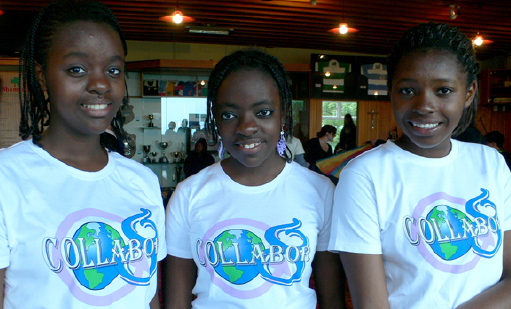
Playing to Shearer’s Strengths: While Green Growth has recently grabbed the spotlight, Aotearoa has as much to gain, in terms of pure marketing advantage, by being seen to be the world’s most humane nation—as opposed to Australia, whose politicians seem determined to portray their country as paranoid and racist. But, as with the tarnished ‘100% pure’ brand, much needs to be done to address an ugly vein of racism in New Zealanders, as these Collabor8 dramatists attest—‘We didn’t know bullying before we came here to New Zealand,’ said Noella Dushime, left. image NewsWire
By contrast David Shearer has personally confronted the reality of helping to feed, shelter and protect vulnerable people in some of the most difficult places on Earth6.
A climate of change
And if population growth and water and resource depletion aren’t sobering enough, we need to be honest about the threat of climate change7.
Despite the fact that in a recession, people are more focussed on the short-term challenges of making ends meet, if the science is reliable, then this is a longer-term issue we cannot afford to ignore8.
Our National Institute of Water and Atmospheric Research (or NIWA) says the Earth’s sea surface temperature around New Zealand has increased approximately 0.8 degrees since 19009, mostly in the last several decades.
Because of the lags between greenhouse gas emission and climate adjustment, the Intergovernmental Panel on Climate Change (IPCC), estimates at least a 1.4 degree rise above 1900 levels even if no more greenhouse gases were emitted10. This is already forecast to affect the severity of floods, storms and droughts.
The IPCC’s worst case, if nothing is done to limit emissions, is for warming in the range of 2.4 to 6.4 degrees by 2100, and the latest tracking data has us close to the worst case. A six-degree rise risks setting off a self-reinforcing cycle of polar ice cap and tundra melt, natural increases in methane emissions, sea-level rise, and reduced climate buffering by the world’s oceans1. Stopping this, according to the IPCC, requires emission reduction of at least 25–40% below 1990 levels.
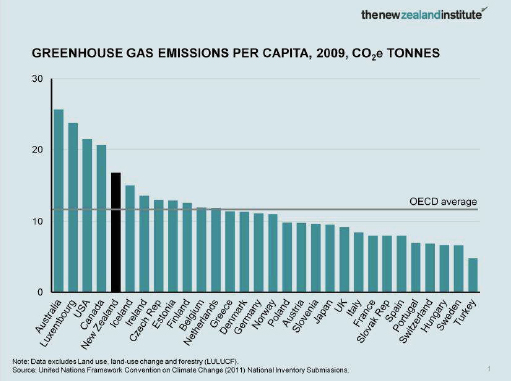
Up There with the Worst of Them: For a country that fancies itself at being the best at everything, the scorecard for Aotearoa is exceedingly ordinary when it comes to the attributes critical for success in the 21st century. image New Zealand Institute
New Zealand’s carbon emissions are the fifth highest per capita highest in the OECD and they’ve increased 23% since 199012. Labour committed to a comprehensive, all-gas, all-sector emissions trading scheme as one of this country’s domestic responses to climate change. This will help contain domestic greenhouse gas emission while ensuring minimum disruption to our economy. By contrast, National quickly set about watering our scheme down and delayed the introduction of agriculture into it, which is responsible for nearly half of New Zealand’s greenhouse gas emissions. There is still no real commitment for agriculture to enter soon.
Of course nothing less than global action will be required to solve this problem. But to play its rightful part, and to protect its clean, green brand, New Zealand must lift its game achieve that.
Given that there is still no legally binding successor to the Kyoto Protocol after 2012, the outlook for global climate disruption remains grave. We are approaching a point where the number of people on the planet will be greater than the earth’s ecosystem can sustain. It’s impossible to know exactly where that point is—some say we have already passed it and are living in deficit; others say it is soon; far too many say they don’t believe it, or just don’t care.
But when I look at my two sons, I fear that our generation has failed them. They will inherit a world far more difficult and more treacherous than our own. So, if we care about our kids and grandkids, we must act with moral courage now to give them the best possible chance of navigating this uncertain future.
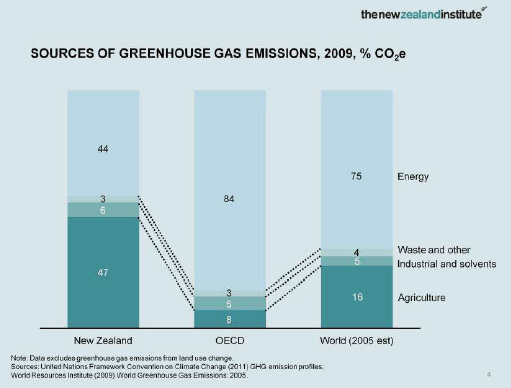
World Leaders: Not only do New Zealanders have the fifth largest carbon footprint in the OECD, but the emissions profile reflects the proportionately large, and growing, methane content—a gas that traps 21 times more heat than carbon dioxide. The one concrete climate action contribution of the National-led coalition is the establishment of the Agricultural Greenhouse Gas Research Centre—developing the means to reduce agricultural greenhouse gases is arguably more productive than merely trading them. image New Zealand Institute
There are no islands
The climate debate reminds us that there is no such thing as an island when these global megatrends collide.
Sure, let’s accept that New Zealand does start with some advantages. We have wide-open spaces, plentiful rainfall, fertile land and low population density. The World Bank estimates that we are blessed with 8th highest level of ‘natural capital’ per person of any country on the planet13.
According to some, our temperate climate and surrounding oceans may buffer us from some of the most extreme climate disruptions. It will still rain, although with more on the West coast, with more droughts in the East. NIWA already estimates that the droughts of 2007 and 2008 cost the country $500 million and $1 billion respectively14. But if the consequences of climate change, population growth and resource constraints are even half right, we may well be living in a world that is very different to the one we take for granted today.
Frankly, if we think the financial hangover of reckless lending and borrowing of the last decade is bad—the consequences of another major oil shock and sweeping climate-induced poverty and disruption could be horrific. In such a world there are no ‘islands’. Or at least none that can guarantee the security of their supply chains or their ability to send products and services safely and cheaply to distant markets. Our domestic economy is not resilient today. Our low population density has allowed us to maintain a ‘100% Pure’ image, but the reality is different.
Despite us trading on our clean and green image New Zealand is the only country in the OECD without statutory requirement for regular reporting on the state of our country. Instead we have to rely on others to tell us what’s happening. Having worked in my first term in Parliament to advance triple bottom line reporting, I now believe the time has come to put alternative wellbeing measures alongside ‘GDP’. ‘Gross domestic product’ measures pollution and crime as ‘goods’ as long as they show up in turnover. Labour in government began work on alternatives to GDP measures, and it is high time that complementary measures became standard in our economic reporting. Grant Robertson has a member’s bill in the ballot to this effect.

Behind in Green Race: Pure Advantage reports that Aotearoa is lagging badly behind in the green growth race. The lobby group is somewhat fatalistic about the chances of government leadership, and suggests a strategy of encouraging large corporates to lead the way. Meantime, Britain’s Baron Drayson is leading a charge to raise the profile of electric cars, with this 850-horsepower Le Mans prototype that is debuting at the Goodwood Festival of Speed this weekend. image New Zealand Institute
The Pure Advantage report recently released, New Zealand’s Position in the Green Race, calls for a ‘100% pure reality check’15. They note New Zealand has already slipped down Yale University’s Environmental Performance Index (EPI) from 1st in 2006 to 7th in 2008 to 14th in 201216. The UK ‘food miles’ debate may not have been based on great science (as many of our year-round outdoor farming has a lower energy intensity than barn-fed animals), but its adoption by large supermarket chains shows us that perception matters17.
Our water quality is under threat. Yale University’s water index has us 43rd of 132 countries18. According to the OECD, three quarters of our water supply is used for irrigation19, but that resource is un-priced (free) to the farmer and, under National, has just received an additional $400–million subsidy. Little wonder many more catchments are 100% allocated, and that total nitrogen trends are way up around the country20.
Our cities sprawl, so we have low urban population density and under-developed public transport infrastructure. New Zealand has the third highest rate of car ownership in the world, but one of the lowest usages of public transport21.
Our housing is famously cold and damp and draughty. It causes too many of our children grow up with respiratory disease and lifelong impairment22.
And our track record on biodiversity is appalling. We should have woken up to this long before DOC research had to tell us that there are probably on 55 Maui’s dolphins surviving. Further action is needed to protect endangered species23.
There is much more to say on conservation than we have time to today. I am hopeful that we will be able to welcome Labour’s Conservation Spokesperson, Hon Ruth Dyson, to speak with us in the West.
Take action and good results are possible. Locally, thanks to Lynne Pillay, Bob Harvey, Penny Hulse, Denise Yates and many others, the Waitakere Ranges Heritage Protection Area Act set a new benchmark in addressing the cumulative effects of urban development and setting strong goals for preservation of our unique and beautiful ranges.
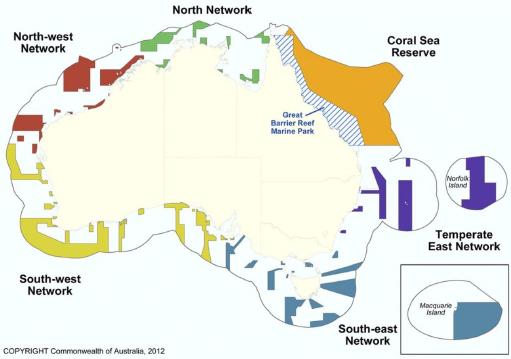
Australia Plans for 33% – Aotearoa Settles for 0.03%: ‘Now that Australia has just created a whole raft of marine protected areas, the time has come for renewed discussion about mixed-use marine parks and reserves.’ map Department of Sustainability, Environment, Water, Population and Communities
Now that Australia has just created a whole raft of marine protected areas, the time has come for renewed discussion about mixed-use marine parks and reserves.
I could go on all afternoon about the threats to your safety, but I suspect you’d just become overwhelmed and depressed. Let’s talk about solutions rather than problems.
The clean-tech revolution
So the world is facing major environmental challenges, and New Zealand faces both global and local risks.
What contribution can clean technology and renewable energy make to addressing these risks and taking New Zealand forward on a more resilient and sustainable basis?
Let me say from the outset that the serious nature of these challenges, there is zero room for ‘green-wash’ in this debate. The National Government, for example, set ridiculously tight terms of reference for its Green Growth Advisory Group, to ‘green’ the government’s existing growth agenda and to ‘leverage’ New Zealand’s clean, green brand. That is, respectfully, the opposite of what we need. We need to live the brand, not to leverage it.
We need a structural shift in how our economy works, not green-wash dreamed up by some marketing guru. What does that mean? It means creating more economic value with less carbon, energy and pollution footprint. Through clean technologies we can potentially improve the value and the sustainability of our primary industries. We can create new export niches by developing solutions onshore that can be sold and replicated offshore.
The interests of a high-value, full employment economy and a sustainable environment are not necessarily opposed, but can work together.
Clean-tech: Old and new
Put simply, reducing waste and reducing pollution can make things run more efficiently. Like a car exhaust. Tune the car properly, get the oil mix right, and there are less fumes. The car runs better and cheaper, and pollution is lowered.
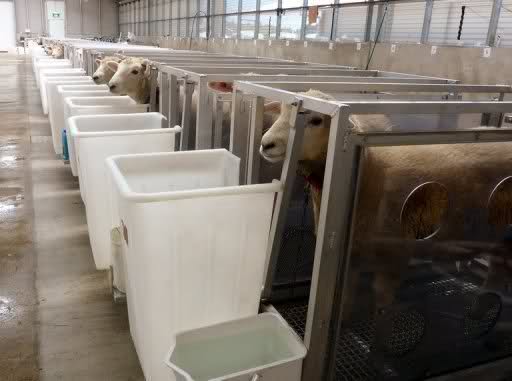
Methane Silver Bullet: Thanks to Prime Minister John Key appointing the country’s first chief science advisor, Professor Sir Peter Gluckman, Aotearoa is now a global centre for research into anthropogenic greenhouse gases. A vaccine under development that targets only methane-producing microbes may prove to be a win-win for farmers—increasing digestive efficiency in livestock, while reducing the amount of methane released to the atmosphere. image Agence France-Presse
Likewise, research into cow ‘exhaust gases’24 is seeking to reduce greenhouse gas emissions at both ends, and improve the nutritional value of feedstock and the productivity of dairy farming.
Research into soil carbon is trying to fix more carbon into soils, both to reduce our net carbon emissions and to improve soil fertility25. As an example, across the harbour from here on Puketutu island, The Living Earth Company processes about 90% of the greenwaste that Auckland generates. Previously all of that would have made about 25% of the entire load going to landfills every week in the Auckland region. Instead it has revolutionised the old backyard veggie plot into a vast landscaping and gardening industry, turning that entire waste stream into money. If any of you have gone to a concert at the Villa Maria estate in Mangere, you will be surrounded by their Biogro certified compost and eco-mulch.
Clean green business isn’t just happening on the farm or in the garden—it is stuff as obvious as eco-tourism ventures—from whale watching to guided tramping.
It’s in the organic fruit drinks that made Phoenix and Charlie’s household names and valuable brands. But it’s a shame that this innovative company, like so many others, has been bought from offshore and delisted from our stock exchange26. It’s in sustainable fisheries management, and environmentally balanced aquaculture, much of which is of particular importance to the Maori economy. It’s in new forestry cultivars that produce denser, stronger timber quicker27, and planting practices that better conserve soil quality while improving yield. It’s in the electronic traceability of our livestock28, so that we can demonstrate which animal from which herd on which organic farm is in each premium serving on a European supermarket shelf.
Or in the desperate biological research now underway to save our Kiwifruit industry from the scourge of PSA by developing disease-resistant cultivars29. Or in the nutritional research that is helping Fonterra and others like A2 to extract advanced proteins, nutraceuticals, lower intolerance and higher pay-outs from a bucket of milk30.
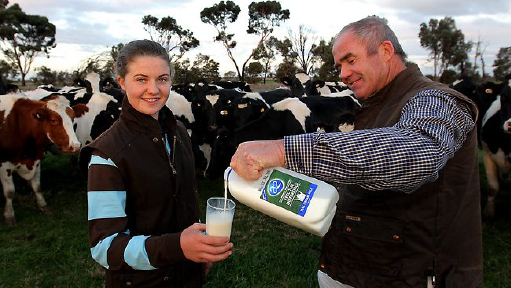
Do No Harm: ‘Changing dairy herds to produce more A2-producing cows may significantly improve public health, if the A1/A2 hypothesis is proved correct, and it is highly unlikely to do harm.’ Professor Boyd Swinburn, Deakin University. Rather than wasting years in its reactionary resistance to A2 milk, Fonterra could have been sweeping the world with this potentially good news story—presumably Fonterra’s new chief executive, Theo Spierings, will steer the cooperative in a more positive, and profitable, direction. image Herald Sun
Clean technologies can not only add value to primary products, they can create value from by-products. For example, Lanzatech is trailing turning the exhaust fumes from Glenbrook Steel mill into fuel and production chemicals31.
There are many other ground-breaking breakthroughs being made in New Zealand. We need to get behind this shift or we’ll see bigger companies purchasing or just taking the intellectual property and benefit while Kiwis put in all the hard slog.
Renewable energy: Powering the future
Clean technology is also helping to generate renewable energy and to better utilise and conserve the energy we have.
The supply side
New Zealand state owned energy companies like Mighty River Power are already world leaders in renewable geothermal energy. Through a subsidiary, Mighty River Power is assisting countries like Indonesia develop geothermal resources32. And yes that’s the same Mighty River Power the Government rammed through legislation to partially privatise this week. Doing so—despite the clear opposition of New Zealanders and the lack of a financial case—shame!
Solar energy also holds potential. For example SolarCity is currently putting industrial solar panels on the roofs of 2200 new homes in quake-hit Christchurch33. Experts disagree over the full delivered cost of solar energy, but there is no question that it is coming down, and reaching large-scale production of photovoltaic cells will help.
Alternative energy supplies may be found in the forestry industry, with potential to use post-felling wood residue for biomass energy conversion34. Almost as soon as biofuels appeared on the market offering viable alternatives to fossil fuels, so did the campaign against them. It’s not as simple as ‘biofuel good, petrol bad’. The PCE pointed out in her 2008 report that biofuels, if not properly regulated, can potentially be worse for the environment than fossil fuels. They can emit more greenhouse gases (e.g. Indonesian palm oil). They can add to starvation by replacing food crops in order to benefit from big government subsidies. And they can decrease biodiversity (by clearing rain forests to plant biofuel crops). However these dangers can be mitigated and in Labour’s 2008 biofuels obligation legislation we worked with the Greens to develop sustainability standards which ensured that only biofuels from truly sustainable sources could be sold in NZ.
The potential for biogas is being increasingly acknowledged and leveraged around the world and this innovative Kiwi company Flotech is at the forefront of this technology. Ironically they have struggled to get any traction here at home despite their pilot plant at the Redvale landfill in Rodney, extracting 90% of the methane produced by that landfill and converting it for onsite electricity generation. Redvale landfill is in the top ten largest gas fields in New Zealand and is currently Auckland’s leading producer of renewable electricity capable of powering 11 000 homes or providing enough alternative transport fuel to replace 54 million litres of diesel a year.
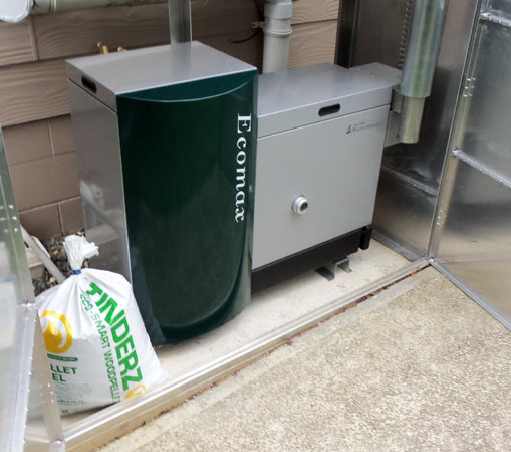
Pumping in the Heat: Heat pumps rely on the ambient air not being too cold and damp, such as is often not the case in Christchurch. Not only are wood pellet burners, such as this Dunedin-manufactured unit, immune from that problem, they represent are much more efficient use of energy, and one that would otherwise be going to waste on the forest floor—they are also clean-burning, compared to Christchurch’s controversial log-burners. image Ecomax
The Parliamentary Commission for the Environment (PCE) has identified wood waste to diesel technology as a major development opportunity35.
So whether it is wind power, geothermal, bio-waste, bio-mass or bio-gas—and provided we are vigilant to avoid the risk of biofuels—there is huge potential in alternative and renewable energy to make a positive difference to our future.
The demand side
Clean technology can also help improve the efficiency of the energy that is produced. For example smart grids with two way metering allow households to pump surplus power back into the grid when they produce more from say, solar panels, than they need. The OECD estimates smart grids can cut peak power demands by up to a quarter36. The PCE recently urged more attention to smart meters and grids as a way of improving grid efficiency and streamlining grid upgrades37.
Reduced consumption may mean reduced revenues to privatised power companies, so we need to ensure that future governments’ rights to regulate the energy market in the public interest—including for smart grids and two way meters—are not eroded.
Who is sick of spending winter living in cold, damp draughty wooden houses? Plenty of people in this room I bet.
But it’s not a matter of choice for the 230 000 plus Kiwi kids growing up in poverty38. We live in a country where those kids get sick way too often with respiratory disease and suffer the consequences all their lives39.
There’s nothing particularly high-tech about installing batts in a ceiling, or insulation in walls. But home insulation and double-glazing is not only good for energy efficiency and a lower carbon footprint—it is essential for public health, fairness, and a productive workforce in years to come. I know the government makes a big noise about its home insulation scheme, but actually, the National government’s scheme is barely scraping the surface. For example, a staggering proportion of your expensive home heating goes straight out through your windows. Double-glazing, which simply means two panes of glass instead of one, cuts this heat loss in half40. The savings in health and energy would run into millions, from this simple step. Double-glazing also dramatically reduces the level of noise that enters your house.
Here’s another simple example: LED lights use far less energy, they have a pleasant glow, they’re cheap and they last for years. Why not campaign to encourage homeowners and businesses to convert to LEDs? Why not start with the government departments?
A 100% reality check
Oil and toys
But let’s imagine, just for a moment, that we had a different government, a government of values and vision, of principle and pragmatism—maybe a Labour-led Government with a green tinge, I hear you ask?
If we had such a government, and we took clean technology and renewable energy seriously, could we ‘close the gap’ (yeah I reckon we’re allowed to use those words now) between the lifestyles many people want and the future we are going to get?

Not a Plastic Toy in Sight: ‘…we’re going to have to learn to live better, more satisfying lives with less pollution and less wasteful material consumption, not more.’ image Newswire
The answer, honestly, is no. A ‘100% reality check’ means that we’re going to have to learn to live better, more satisfying lives with less pollution and less wasteful material consumption, not more. On a planet of seven billion souls, we can’t all live according to some 1950s ‘American Dream’.
It’s hard to believe, these days, but before the so-called economic reforms of the 1980s, most New Zealanders believed that it was a good thing to live a relatively modest lifestyle. People may have craved consumer products like better cars and larger TVs, but, by and large, people accepted the very important principle that you can’t always have everything you want.
When I was growing up, children received one or two major presents a year: a large toy or a doll or a set of books. Older children passed their toys down to younger children. These toys were valued in the same way that adults value their cars today. Today a lot of Kiwi kids—not the 20 000 still growing up in poverty—have a room full of toys. Whereas a new toy was once a major event, now it’s simply a way of keeping children quiet while the parents go shopping.
When I was growing up, toys were generally well built and they lasted. We’ve still got one or two of my childhood toys. I gave them to my sons. Now, toys are mostly cheap plastic junk. Do you know what those toys are made of? They’re made of oil. That’s right. Oil.
I think, in 100 years time, our great-great-grandchildren will scarcely believe that, even while the world’s oil supplies were known to getting harder and more expensive to source, the citizens of the Western world filled their homes with needless junk that was mostly made from oil.
Is this sustainable? Of course not. Yet we keep squandering our children’s inheritance as if there was no tomorrow.
Myths and reality
Almost as bad, we willingly believe the myths and lies of some governments and industry leaders, because we want to.
Shall I list some of them? The biggest one is the lie that we’re going to be able to continue to live our current lifestyle, using alternative technologies. This is probably one of the worst. Even some environmentalists do it.
It’s tempting to settle for tiny steps forward, because it is hard to get people focused on the future when life is so tough for so many today. Some are even so sick of being rejected by the mainstream that they’ve started to talk the language of the corporations.
The endless energy myth
I read a report a year or so ago, which estimated that renewable energy could account for almost 80% of the world’s energy supply within four decades—but only if governments pursue the policies needed to promote green power41.
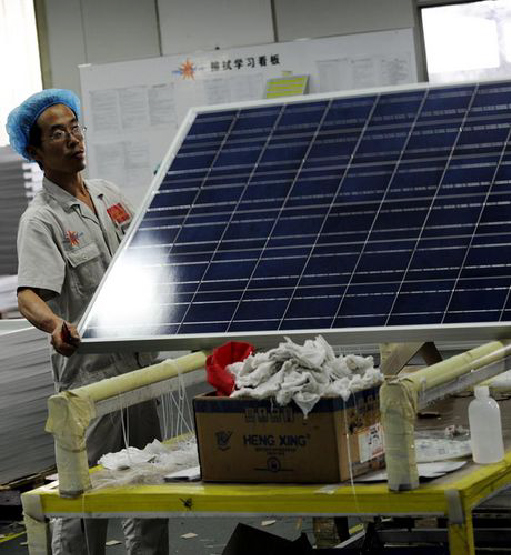
Inexorable Rise in the Cost of Electricity: The popular perception powered by recent falls in the price of Chinese-manufactured panels—a heavily subsidised industry—is that photovoltaic power will soon be powering every household. A more sober estimate is that renewable energy will require ‘that the ratio of energy investment to GDP would have to be much more than 9 times the rich-world average.’ image Bloomberg
Sounds good, doesn’t it? The fine print was that governments around the world, which are currently struggling to survive financially, would have to spend hundreds of billions on new energy projects. Energy bills would have to rise to pay for all this. Not a little bit, a lot: enough to make you turn your household heating off in winter, except maybe in one or two rooms.
There’s a fundamental problem: our society has been built on cheap energy. Really cheap energy, most of it based around oil. We expect to be able to drive to the supermarket and buy 50 different types of food from all over the world.
Do you know that fish is caught off the cost of the South Island, then shipped to China for processing, then shipped back to New Zealand again. Really? How is this possible? Two reasons: one is that the South East Asian crews and the Chinese factory workers aren’t paid enough, and the other is that oil is still cheap enough to make it worthwhile shipping frozen fish half way around the planet for processing.
The green revolution myth
I’m sure you’ve all seen those photos of farm life in the 1930s. Those days, as you know, are long gone. After World War II, farm life changed almost beyond recognition.
It’s sad that the term for this change was (wait for it) the Green Revolution. The Green Revolution was a sadly misplaced name for industrialization of agriculture.
Farms became much more productive, which was a good thing, or so it appeared at the time. Part of this increase in farm production came from new hybrid food plants. Part of it came from new technology such as milking sheds. Most of the rest of the Green Revolution was powered by oil. Oil and natural gas powered the tractors, oil powered the pumps that irrigated dry lands, natural gas was converted into fertiliser, and oil was converted into insecticides for pest control.
The good news is that between 1950 and 1984, world grain production increased by 250%42. The so-called Green Revolution was the reason there are 50 types of food in your supermarket.
The bad news is that the amount of energy required by agriculture increased by many times compared to traditional agriculture43. Many times. And most of this energy came from fossil fuels. Are you worried? You should be.
The clean cars myth
I know it’s wonderfully seductive to imagine a world where you drive to work in an electric car powered by hydroelectric power. However, I’m not so sure that electric cars are as green as they claim to be. Did you know, for example, that about half the components in a modern car are made of plastic? Guess where that plastic comes from? Mostly oil.
There are currently 3.4 million cars registered in New Zealand. Only about 46 are powered by electricity44. If we increased that volume 100 times, we’d still only be running a tiny fraction of the vehicle fleet on electricity. If we attempted to replace even a large hunk of the vehicle fleet with imported electric cars, we’d simply bankrupt the country.
At rush hour, in Auckland, it can take me over an hour to drive from North Auckland to West Auckland. What difference would electric cars make? Can anyone here look me in the eye and say that massive traffic jams full of electric cars are really much of an improvement? Of course not. What is really needed is a rail link. Imagine a fast, reliable rail link, direct from the North Shore to West Auckland. That’s a far better use for our precious hydroelectric energy, and the only sure way to make our cities liveable.
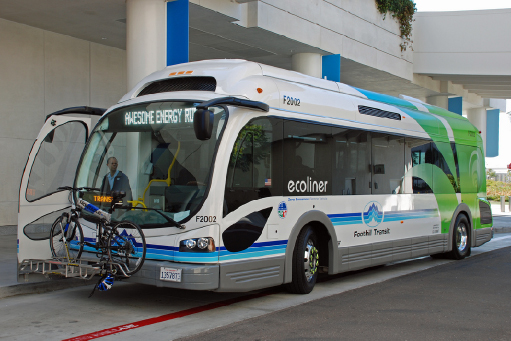
Joining Up the Dots: While a comprehensive rail network for the region was once the rational way forward, the fateful 1955 Master Transportation Plan for Auckland locked in half a century of motorway building. The good news is that, with the advent of battery, trolley and hybrid buses, the road network can now be partly be made over to buses and busways. image Foothills Transit
Or at least a modern joined up network of rail, buses and ferries?
As anyone who has sat in a two-hour Auckland traffic jam will tell you, the one-car-per-person model simply doesn’t work anymore. I’d rather do the same trip in 20 minutes on a train with onboard wi-fi and a flat white to go.
Did you know that the government’s own studies show that transporting goods by rail is over five times more efficient than transporting goods by truck? So what does our government do? It builds more roads and, despite Labour’s KiwiRail buyback, under-funds rail. This is madness.
If you want to know why the government wants to spend your money on roads and not rail, here’s a hint: the head of the trucking lobby is usually either a former National Party cabinet minister or a former Act Party leader. Do you see a pattern here?
Rail doesn’t just benefit you personally, either; the more we invest in rail, the less we spend on imported cars and oil. The more we invest in rail, the more local people get employed at every level.
The more we invest in rail, the more we build resilience for our future, while providing for our everyday need for reliable transport and affordable energy.
Two ‘lifestyle’ myths
Finally, we need to think beyond two equally false lifestyle myths.
The first is that we run a world on sustainable energy and maintain our ‘current’ lifestyle? I don’t think so.
Let me quote ecologist Richard Heinberg45:
I went to the Aspen Environmental Forum for two years in a row and … whenever the subject of our oil problem comes up, or our car dependency problem, the only thing that they want to talk about is running all the cars differently by other means.
They don’t want to talk about walkable neighbourhoods, they don’t want to talk about inhabiting the landscape differently, they don’t want to talk about public transit, they don’t want to talk about fixing the conventional railroad system.
Our energy expectations have grown beyond the wildest dreams of our ancestors. And they’re continuing to grow. This energy-intensive lifestyle is simply unsustainable. It’s probably unsustainable for Westerners. It’s completely impossible for seven or nine billion people. New Zealand is unique in that much of our energy comes from hydro-electricity. But do we have enough energy to maintain our current lifestyle into the future? The simple answer is ‘no’. The current government is living in a fool’s paradise, or is simply unwilling to confront the vested interests and tell the people the truth.
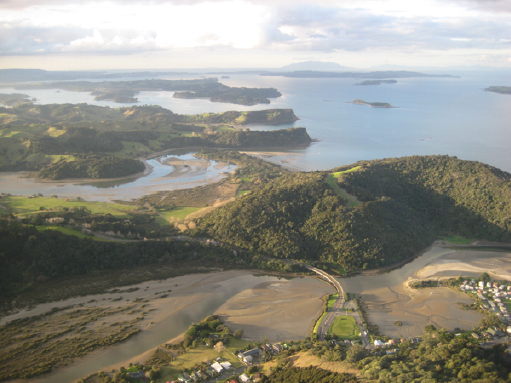
For a Richer Aotearoa: Living lightly on the planet does not mean living a hair-shirt existence. Without owning a car, electric or otherwise, Aucklanders can be whisked to Waiwera and live like kings for hours or days at a time in the nearly 900 hectares of coastal regional parkland—just a 62-minute express bus ride from Wellesley Street. image ImageShack
The opposite lifestyle myth is that all economic development is bad and that living a hair-shirt existence is our only option. Rubbish. With robust evidence-based analysis, proper planning and incentives, and most of all with public will and imagination, there is an opportunity for more people to live better, healthier lives by learning to live differently.
Do I support clean-tech strategies such as renewable energy and wood-waste biofuels? My answer is quite simple: I support any moves that reduce our exposure to ecological crisis. Will these savings help? Yes. Do they solve the basic problem that we’re living a lifestyle we can’t afford? Probably not.
We have a huge gap to fill between the future we want for our kids and the trends we are facing. Every concrete step to close that gap will help. We must not be seduced by the old materialist myth of the ‘American dream’, nor frozen by despair at the magnitude of the challenge.
Between the myth of materialism, the trap of despair, and the myth of green-wash, lie tough choices and real adjustments. That is the only way we can build a better future for our children. We must build it with clear heads, warm hearts and above all the courage to change.
Making hard choices
Clear-headed thinking
Let’s add some hard-headed thinking.
Our 100% ‘reality check’ must recognise that sometimes compromise or trade-offs must be part of the plan. Sometimes we cannot avoid hard choices between the goals of the economy and the environment, or ‘the dolphins and the dole queues’ (although I’m for the dolphins on that one). Should we have more swimmable rivers or more dairy runoff? And sometimes we face trade-offs even between different environmental goals. Should we have more hydro power or protect wild rivers?46
Clear thinking is harder because there are no one-size-fits-all answers. That’s why we need good evidence and data, and the tools to use them.
But we cannot, in the face of the obvious, allow paralysis by analysis. As the PCE put it in her Water Quality report47:
While science is necessary for policy, it is not sufficient. Science does not tell us how to make trade-offs, and trade-offs will almost certainly be needed. It is very unlikely that we can have our cake and eat it too. Even if technical fixes were to become available for dealing with all our water quality problems, they would still cost a great deal of money.
We need some real-world rules of thumb to guide us through the economy-environment maze. First: Adopt the precautionary principle. New Zealand should be prudent about anticipating and managing the risks that flow from significant global climate change, fossil fuel constraints and economic turmoil. Second: Resilience—the idea that we should strengthen our capabilities adapting to and managing the consequences of foreseeable environmental disruption. Energy and resource security are obvious examples.
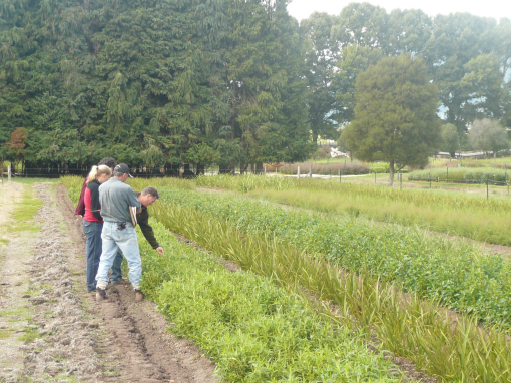
Slashing the Cost of Resilience: With the increasingly wild weather wrought by global warming has come an exponentially increased need for planting to minimise damage to erodible soils. The Mahurangi open-ground project is helping to re-start work begun in the 1950s on the large-scale production of indigenous plants, forestry-style. image Michael Bergin
As my colleague the Hon Lianne Dalziel says, resilience goes hand in hand with sustainability. Lianne should know—she’s just been appointed to the UN Office for Disaster Risk Reduction Advisory Group of Parliamentarians on Disaster Risk Reduction, in recognition of her work in making Christchurch a more resilient city.
I strongly believe that resilience is a concept that we will be talking a lot more about.
Leading change
No matter how ‘worthy’, the change we need will not just ‘happen’ by accident. Markets are notoriously short term. Financing breakthrough technology development is tough.
Labour believes government has a crucial role to play in supporting or incentivising new technologies until the market is ready to take over. Take wind farms. The last Labour government awarded grants to assist the initial deployment of wind technology through the Ministry for the Environment. Before long, the volume of orders increased, wind farms were proved to be economic, the subsidy was backed off and the market took over48.
New Zealand’s science investment is still pathetic—less than a third of Denmark’s and about one quarter of Finland’s. There is so much more that we could do to release Kiwi ingenuity to assist both the economic and environmental challenges that face us.
It is a crying shame that this government refuses to take seriously the clean-tech agenda, refuses to invest properly in our innovation ecosystem, refuses to lead the market to a better tomorrow on behalf of all New Zealanders.
Getting the best long-term outcomes will not always mean maximising short-term profits. It can’t. Anyone who tells you it can is either stupid or lying.
It’s disappointing that Steven Joyce, the minister of economic development, attacked the Pure Advantage green race report this week, saying that it would require a ‘value destroying’ adjustment of our economy49. Do people like him understand the costs of not adjusting and not planning for a better future? Do they understand that business as usual simply cannot continue?
Just as New Zealand cannot ‘cut and sell’ its way out a recession, we can’t mine and drill our way through a climate–disrupted, resource-depleted future.
Achieving change
For those of you who think change is some naīve dream, let me tell you a little story.
In the 1860s, greedy British ship owners were overloading their boats. If the overloaded ship made it home, the owners made huge profits. If the boat sank, as many of them did, the ship owners got a huge insurance pay-out.
This cosy ‘coffin ship’ arrangement cost many thousands of innocent people’s lives. The ethical ship owners were pushed out of business. The coffin shippers grew rich. Does this sound familiar? Just as today, everyone knew what was going on and everyone said that the exploiters were too big and powerful to be controlled. Wrong.
Latter-Day Plimsoll Line: Plimsoll Award –winning virtual beacon system by Auckland-based Vesper Marine could have averted the Rena running at full speed into the still unmarked Astrolabe Reef—Astrolabe could be virtually marked, by a transmitter located on Motiti Island. Possibly Prime Minister Key believes, as he did after the Rena was left leaking oil in calm waters for nine days before practical action was taken, that ‘the reality is it’s always much trickier and more difficult when you’re in the middle of it.’ Montage Mahurangi Magazine
A British MP, Samuel Plimsoll, took on the shipping companies, and in 1876 the British parliament passed an Act that required all ships to carry a simple measuring line on the side50. If this line on the side of the ship was above the water, the ship was safe. If this line on the side of the ship was under water, the ship was overloaded. This line on the sides of ships was quickly called the Plimsoll line, and you can still see the Plimsoll line painted on the side of ships today. Plimsoll’s heroic efforts have saved millions of lives. The coffin shipper industry barons attacked Plimsoll from all sides. And they lost.
So, is it possible to take on the bastards and win? Yes it is. Who gains when we do this? Everyone. So that is why, when we are re-elected, our loyalty must be to the people of New Zealand and their families.
Conclusion
Everybody loves to hate politicians. Yet, we politicians are here because people voted for us. Politicians tend to do what’s easiest for them and their careers. Although there are a few of us that really care, we can’t force our policies onto unwilling voters.
So, I think that the big changes in the world; the ones that might just save us, are going to be driven by ordinary people like you.
But a word of warning: the road to hell is paved with good intentions. It’s not good enough to have ideals. It’s not good enough to weep over the state of our nation’s waterways and land. It’s not good enough just to bemoan climate change and inequality. In between our dream world and our present world, there’s a minefield of confusion, denial and dishonesty, of myths blue and green.
Let’s not get sidetracked by the wonderful fantasy that we can continue living a 1950s American Dream lifestyle. Nor be deterred from harnessing every bit of Kiwi ingenuity, every good idea, for a more resilient and sustainable future. I would love to say that’s all we need to do, but it’s not. We need to act on a personal level, a local level, a national level and, finally, a global level.
On a personal level, we need to act in an aware, caring and responsible way. We need to recycle, we need to buy goods from ethical sources, and we need to teach our children the value of doing more with less.
On a local level, we need to support city councils and interest groups that act responsibly.
On a political level, we need to support parties that acknowledge the depth of the problem and are prepared to do something about it. We can’t just close down every dairy farm. We can’t just ban cars and hope that someone builds a railway.
In the meantime, every bottle you recycle, every heater you turn off, every vote that you cast, is one small drop. And, never forget, an ocean is made up of nothing more than small drops. And an ocean is a powerful force of nature.
And, finally never let us forget, that there are seven billion people on this small planet. Like drops in the ocean, we’re all this together.
References and readings
- Martin, J. (2006), The Meaning of the 21st century: an urgent plan for an enduring future, Riverhead, ISBN-10: 1573223239.
- United Nations, Department of Economic and Social Affairs, Population Division, World Population Prospects, http://www.un.org/esa/population/
- United Nations World Food Programme (2012), Hunger Stats, http://www.wfp.org/hunger/stats
- A selection of resources on this topic is available at Nature, http://www.nature.com/nature/focus/water/
- Bradstock, M. (Issue 12), ‘The Great New Zealand Water Fight’, Good, http://good.net.nz/magazine/twelve/features/water-fight
- David Shearer CV, http://img.scoop.co.nz/media/pdfs/0905/David_Shearer_CV.pdf
- Watt, D. (Chief Scientist, National Climate Centre), ‘New IPCC report on extreme weather events highlights increasing vulnerability to climate change impacts’, NIWA statement.
- Watt, D. (Chief Scientist, National Climate Centre), ‘New IPCC report on extreme weather events highlights increasing vulnerability to climate change impacts’, NIWA statement, http://www.niwa.co.nz/news/new-ipcc-report-on-extreme-weather-events-highlights-increasing-vulnerability-to-climate-change-impa
- NIWA (n.d.), Past Climate Variations over New Zealand, http://www.niwa.co.nz/our-science/climate/information-and-resources/clivar/pastclimate
- Summarised in chapter 4 Brown, L. R. (2006), ‘Rising temperatures and rising seas’, Plan B 2.0 rescuing a Planet under Stress and a Civilisation in Trouble, W. W. Norton & Co, New York, ISBN-10: 0393328317.
- ibid. See also the revision Brown, L. R. (2009), Plan B 4.0 Mobilizing to save civilisation (W. W. Norton & Co, New York), ISBN-10 0393337197.
- New Zealand Institute (2011, October), ‘NZ Ahead: Report Card’, New Zealand’s Social, Economic and Environmental Wellbeing: Measuring New Zealand’s Performance so We Can Improve It, http://www.nzinstitute.org/index.php/nzahead/
- TransTasman (2012, April 5), p. 3.
- Cited in Pure Advantage (2012) New Zealand’s Position in the Green Race, p. 26.
- Pure Advantage (2012) New Zealand’s Position in the Green Race, p. 24.
- For methodology and comparative 2012 rankings see Yale University (2012), ‘EPI rankings’, Environmental Performance Index, http://epi.yale.edu/epi2012/rankings
- McKie, R. (2008, March 23), ‘How the myth of food miles hurts the planet’, The Guardian, http://www.guardian.co.uk/environment/2008/mar/23/food.ethicalliving
- Yale University (2012), ‘Country profile: New Zealand’, Environmental Performance Index, http://www.stat.yale.edu/cgi-bin/R/cpmain?iso=NZL%26view%3Dsummary%26thisind%3DEPI
- New Zealand Business Council for Sustainable Development (2008), A Best Use Solution for New Zealand’s Water Problems. Auckland: Business Council for Sustainable Development.
- Ministry for the Environment (2012, May 27). Trends in Total Nitrogen 1989-2007, http://www.mfe.govt.nz/publications/ser/our-rivers-information-sheets/total-nitrogen.html
- Campaign For Better Transport (2011, May 18), Submission on Government Policy Statement 2012, http://www.bettertransport.org.nz/2011/05/submission-on-the-government-policystatement-2012. Cited by Pure Advantage.
- For useful statistics see Asthma Foundation of New Zealand (2011, December 19), Press release: The Asthma Foundation supports the new Ministerial Committee on Poverty, http://www.asthmafoundation.org.nz/files/Poverty/Poverty_press_release.pdf
- Department of Conservation (n.d.), Facts about Maui’s dolphin, Why so special?, http://www.doc.govt.nz/conservation/native-animals/marine-mammals/dolphins/mauis-dolphin/facts/
- For a significant example see Bullis, K. (2010, November 22), ‘Chinese project puts cow dung to work’, MIT Technology Review, http://www.technologyreview.com/news/421771/chinese-project-puts-cow-dung-to-work/
- For a plain-English summary see Kātterer, T. (2010, December), ‘Can we fix more carbon in agricultural land?’, Sustainability: Journal, Swedish Research Council Formas, http://sustainability.formas.se/en/Issues/Issue-5-December-2010/Content/Focus-articles/Can-we-fix-more-carbon-in-agricultural-land/
- Charlie’s Trading Company Ltd (2012), Our company: Asahi beverages, http://www.charliesgroup.co.nz/content/our-company/asahi-beverages.aspx
- New Zealand Farm Forestry Association (n.d.), No. 2 Choosing radiate pine tree stocks, http://www.nzffa.org.nz/farm-forestry-model/resource-centre/farm-forestry-association-leaflet-series/no-2-choosing-radiata-pine-tree-stocks/#The_breeds
- GS1NZ [non-profit] (2008), ‘Global standards a ‘must have’ for NZ livestock traceability’, Scan, p. 9-10.
- Morton, J. (2012, June 15), ‘‘Fightback against kiwifruit killer disease poised to start’, NZ Herald, http://www.nzherald.co.nz/nz/news/article.cfm?c_id=1&objectid=10813130
- A2 Corporation (n.d.)., The science behind A2 milk, http://a2corporation.com/the-science-behind-a2/a2-milk/
- Pure Advantage (2012), Case study: Lanzatech, http://www.pureadvantage.org/blog/case-study/lanzatech/
- Mighty River Power , financial documents presented to past Parliamentary select committees.
- McDonald, L. (2012, February 3), ‘Biggest solar-energy community planned’, The Press, http://www.stuff.co.nz/the-press/business/your-property/6358261/Biggest-solar-energy-community-planned
- Pure Advantage (2012) New Zealand’s Position in the Green Race, p. 36
- Parliamentary Commissioner for the Environment (2010, July), Some biofuels are better than others, http://www.pce.parliament.nz/assets/Uploads/Thinking-strategically-about-biofuels.pdf
- International Energy Agency (2011), Technology Roadmap: Smart Grids, Paris.
- Parliamentary Commissioner for the Environment (2011, August 11), Press release: Urgent need for electricity leadership, http://www.pce.parliament.nz/media/media-releases/urgent-need-for-electricity-leadership-environment-commissioner
- Children’s Commissioner (2010, January). ‘About child poverty’, Child poverty in New Zealand, http://www.occ.org.nz/home/childpoverty/about_child_poverty
- Craig, E., Taura, S., Jackson, C. and Han, D. Y., New Zealand Child and Youth Epidemiology Service (2008, July). The Health of Pacific Children and Young People in New Zealand, http://www.paediatrics.org.nz/Files/The%20Health%20of%20Pacific%20Children%20and%20Young%20People%20(Introduction,%20Viewpoints%20and%20Executive%20Summary%20Table).pdf
- Energy Efficiency and Conservation Authority (n.d.), ‘Window insulation’, Energywise, http://www.energywise.govt.nz/how-to-be-energy-efficient/your-house/insulation/window-insulation
- IPCC (2011, May 9), Special Report on Renewable Energy Sources and Climate Change Mitigation (SRREN), http://srren.ipcc-wg3.de/report
- International Food Policy Research Institute (data set), http://www.ifpri.org/
- Shiva, V. (1992), The Violence of Green Revolution: Third World Agriculture, Ecology and Politics, Zed, ISBN-10: 0862329655.
- Ministry of Transport (2012, May 22), Official Information Act response to Mr Alex Harris, Ministry file number OC00756, http://fyi.org.nz/request/179/response/2254/attach/html/3/OIA%20Request%20Alex%20Harris%20Light%20Electric%20Vehicles%20Cover%20Letter.pdf.html
- BBC News (2012, January 2), ‘Heinberg, Kunstler, Foss, Orlov & Chomsky’, A Public Affair, transcript available at http://energybulletin.net/stories/2012-01-03/heinberg-kunstler-foss-orlov-chomsky-public-affair
- Parliamentary Commissioner for the Environment (2012, May), Hydroelectricity or wild rivers? Climate change versus natural heritage, http://www.pce.parliament.nz/assets/Uploads/Wild-Riversweb.pdf
- Parliamentary Commissioner for the Environment (2012, March), Water quality in New Zealand: Understanding the science, http://www.pce.parliament.nz/assets/Uploads/PCE-Water-Quality-in-New-Zealand.pdf
- Wind Energy Association of New Zealand (2008, December 18), Press release: Wind Energy Association challenges wind myths, http://windenergy.org.nz/component/content/article/22-media08/161-wea-challenges-wind-myths
- Oral Question 4 to the Minister of Economic Development (2012, June 21), Hansard (NZ) Vol 681 Page 1, draft copy available at http://www.parliament.nz/en-NZ/PB/Debates/Debates/3/7/4/50HansD_20120621_00000008-Questions-for-Oral-Answer-Questions-to-Ministers.htm
- Many books have been written about Samuel Plimsoll and the Plimsoll line. You can view a selection here: http://www.fishpond.co.nz/advanced_search_result.php?rid=1883705043&keywords=samuel%20plimsoll or http://www.mightyape.co.nz/search/?i=2812&prev=&s=samuel+plimsoll&SearchButton=Search

I’d love to know how far such thinking has penetrated in Labour. While they did introduce the ETS, I suspect very few MPs or party members appreciate the rapidly increasing seriousness of the climate situation. This has to be brought center stage. Where is the leadership?
Like all David Cunliffe says, but I too wonder if this is now Labour policy. Is it just the political reality of New Lynn, where he only won with Green votes – Party votes Candidate votes Labour Party 12,462 CUNLIFFE, David LAB 16,999 National Party 13,211 GROSER, Tim NAT 11,809 Green Party 4,094